If you want a stove for your home but don't want to deal with the hassle of cleaning and maintaining a wood stove, a gas stove is a great option. Gas stoves can be installed everywhere there is a gas supply, but what are the requirements for gas stove installation?
At Empava, we have decades of combined experience offering stove-related assistance. Continue reading to learn more about the criteria for installing a gas stove.
How to hook up a new gas stove and range?
Installing a gas range or water heater is a straightforward task that requires only a few basic tools and widely available materials. You can also complete the job safely yourself if you use the correct supplies and follow the instructions carefully. For a hook-up, a professional may charge as much as a few hundred dollars.
In this post, we'll teach you how to hook up a gas range with a flexible, corrugated connector (a gas clothes dryer is similar), and how to hook up a water heater with threaded black steel gas pipe.
Most home centers and well-stocked hardware stores carry flexible corrugated gas connections as well as gas pipe and fittings (black). Flexible connections made of stainless steel or coated brass are the only ones marketed these days, and the only ones you can use safely and legally. Corrugated connectors constructed of uncoated brass or other metal, which were sold until the 1980s, have been shown to be dangerous. Do you have one in your home? Now is the time to replace it!
The most crucial step in ensuring a secure installation is to get the appropriate connector. Here are some things to keep an eye out for:
- Purchase a connection with the word "range" or "dryer" plainly written on it for the appliance you're connecting. A range connector's corrugated tube is usually 1/2 in. dia. i.d. (inside diameter), while a dryer connector's corrugated tube is 3/8 in. dia. i.d. (inner diameter). These measurements aren't often written on the package, but they will be for either the range or the dryer.
- Purchase a connector that includes the end connector fittings you require (see Photo 3). The gas line into your kitchen is usually 1/2-in. black threaded pipe, with a male (external threads) or female (internal threads) 1/2-in. fitting connecting it to the stove. Use a black gas pipe fitting on the line to accommodate the end connector fitting if you can't find a connector package with end fittings that match what you need for the gas line. On the gas line, for example, we show a 1/2-in. x 3/4-in. coupling to accommodate the 3/4-in. end connector fitting in Photos 2 and 3. ( See How to Connect for further information on possible connections and how to connect to soft copper supply lines.
- Use a long connector so you have enough of room to work between the stove and the wall. They are available in lengths ranging from 24 to 60 inches.
- Do not reuse a flexible connector; if you purchase a new appliance, you should also purchase a new connector. Follow the connector installation instructions to the letter. Our photos 1 through 5 show how this is done in real life. Here are a few more guidelines:
- Avoid kinking or forcing the corrugated connector into abrupt bends, since this could cause it to break.
- Always look for leaks in your work (Photo 6). Gas leak detectors can be found in home improvement stores, hardware stores, and on the internet.
- Although it is not always necessary to have a range hookup tested, we strongly advise you to get your work checked by a local gas company or plumbing inspector.
Installation Steps( With Photos)
Pull out the range
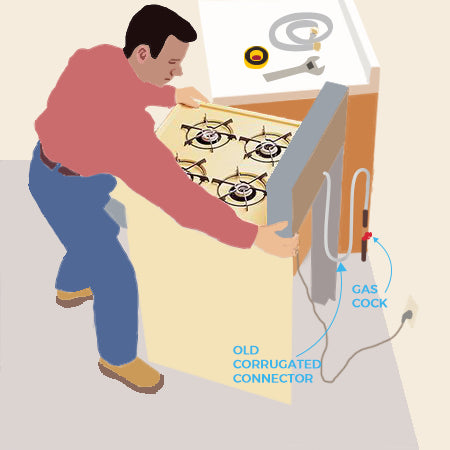
Remove the stove and turn off the gas valve (see also Photo 2). When the lever is at a straight angle to the pipe, the gas is turned off. This shutdown could be behind the range or immediately below it in the basement. A shutdown in the line to the range is essential, and if you don't have one, one should be installed. Don't forget about maintenance; learn how to clean a stove top properly.
Wrap the pipe threads

Wrap Teflon pipe-joint tape across the threads twice in the same direction the fitting screws on (clockwise). Yellow Teflon tape is thicker than white Teflon tape and is used for gas fittings. Because connections with 1/2-in. end fittings on both ends are not always easily accessible, the 1/2-in. x 3/4-in. coupler accepts the 3/4-in. end connector fitting (Photo 3).
Screw the connector to the gas line
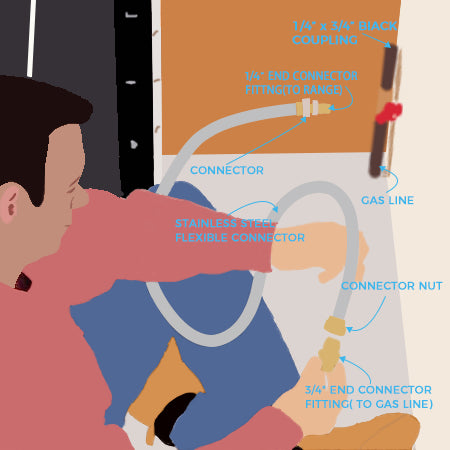
Remove the end connector fitting, cover it with Teflon tape, and screw it to the gas line. Either a male or female end fitting can be used. Always make use of both end fittings that may be removed. NEVER attach a black gas fitting or pipe to the connector nuts on the ends of the corrugated tube. This would almost certainly result in a spill.
Use a street elbow
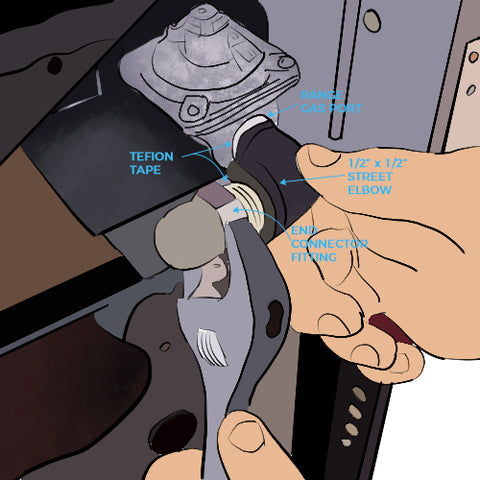
In the range gas port, screw a 1/2-in. x 1/2-in. street elbow (male threads on one end, female threads on the other). Then screw the other end of the connector into the street elbow. Tape each fitting with Teflon tape. Avoid overtightening to avoid putting undue stress on the gas port fitting on the stove.
Tighten the nuts
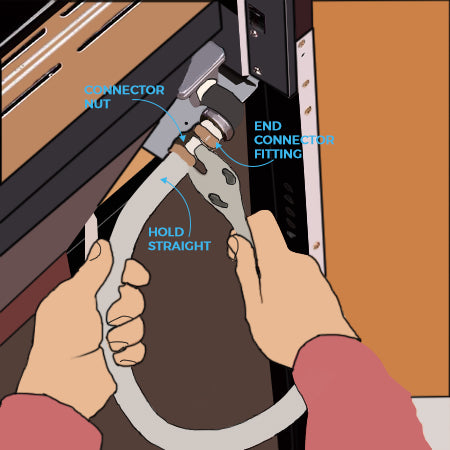
Connect the two end connection fittings by tightening the connector nuts. Hold the tube straight against the fitting while tightening the bolts. Teflon tape should not be used on these threads. The end fittings' beveled edges are designed to provide a tight seal against the corrugated tube's ends. The use of tape may obstruct the seal.
Check for leaks
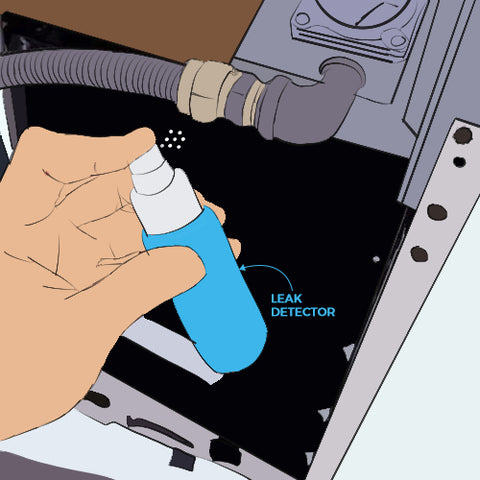
To get the air out of the gas line, turn on the gas cock (vertical position) and light the range burners for around a minute. Then use a gas leak detector to spray all of the joints you've made (sold at home centers). You can also do this with warm, soapy water. A leak will be indicated by bubbles surrounding a joint.










